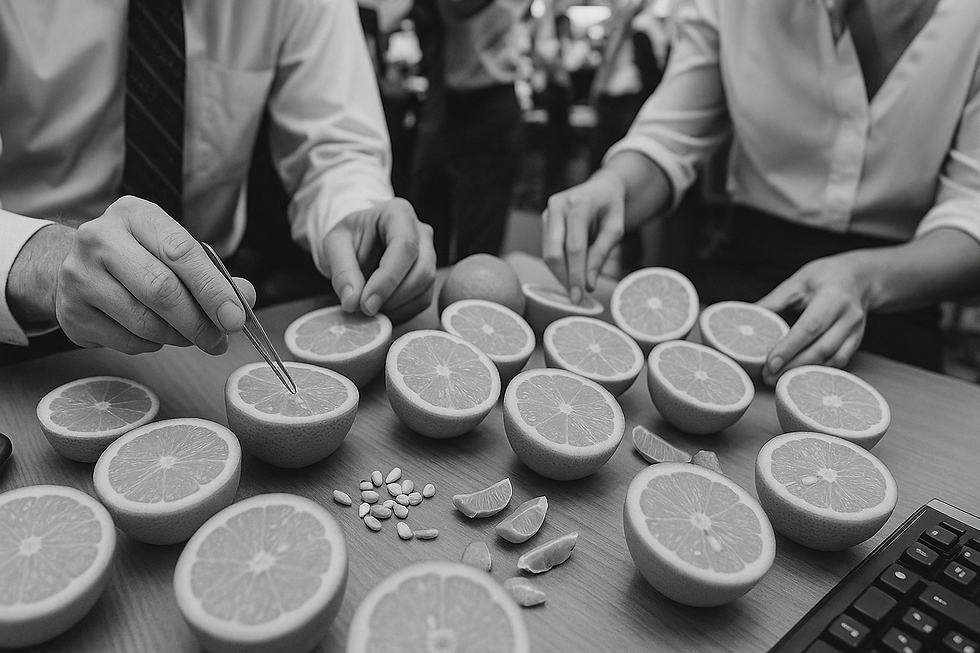PIP, PIP, HURRAY! UNDERSTANDING THOSE TINY MARKET MOVES
- Susi Hogan

- Jul 14
- 3 min read
Updated: Jul 20
Trader Terms to Cook Your Noodles – Vol. 3
You’ve survived the chaos of the trading floor, tackled ‘going long’ and ‘going short’ (without stretching yourself or folding in half), and now it’s time to tackle something so tiny, it sounds almost pointless — but isn’t.
Today’s noodle-cooker: the humble *pip*.
THE “TRADING FLOOR FOLLIES”: OBSESSIVE PRECISION Pips don’t sound like much. And honestly, they aren’t — they’re the **smallest standard price movements in the currency market**.
But in trading? Small doesn’t mean insignificant.
WHAT EXACTLY IS A ‘PIP’ ANYWAY?
Imagine you’re checking exchange rates for your next holiday. You might see something like “£1 = $1.2750”. Then later it changes to “£1 = $1.2751”.
That last digit? That’s a pip.
A pip stands for “Percentage in Point” or “Price Interest Point” — but really, it just means: **a teeny-tiny shift in price**.
- For most currency pairs, the pip is the **fourth number** after the decimal.
- So if EUR/USD moves from 1.0850 to 1.0851 — that’s 1 pip.
- For pairs with the Japanese Yen (like USD/JPY), it’s usually the **second decimal**.
- USD/JPY going from 145.20 to 145.21 = 1 pip.
(Yes, there’s such a thing as a fractional pip — a “pipette” — shown as a fifth or third decimal place. Ignore that for now. We like to keep things human.)

WHY DO THESE TINY MOVEMENTS MATTER?
Because when you're trading larger amounts, those small movements scale *fast*.
Let’s say you go long on EUR/USD and trade 10,000 units (a common trade size called a “mini lot”).
- If the price moves 1 pip in your favour, you might earn around £0.80.
- 10 pips? £8.
- 50 pips? £40.
Now imagine trading 100,000 units. Or more. Those little pips can pack a punch.
**Pips are how traders measure profits, losses, targets and risks.** They are the trading ruler we all use.

OTHER ‘MARKETS’ (AND NO, NOT TESCO)
You're absolutely right to ask — what do we mean by “other markets”? No, you’re not running trades down the frozen aisle.
In trading, a “market” is any space — usually digital — where an asset is bought and sold. That includes:
- **Currencies** (where we use pips, as above)
- **Stocks or Shares** (like Apple, Tesco, BP)
- Movement measured in points or pence
- **Indices** (like the FTSE 100 or S&P 500)
- Also move in points. E.g. FTSE moving from 7900 to 7901 = 1 point.
- **Commodities** (gold, oil, wheat, etc.)
- Measured in units like dollars per ounce or barrel
Every market has its “pip-like” measure — just with different names. The key is this:
> Small changes + big volume = meaningful outcomes.

CLIK’S INSIGHT: MAKING PIPS WORK FOR YOU
At CLiK, we don’t just throw numbers at you. We show you:
- How to calculate pip value in your own trades
- How to measure risk using pip distance
- How to set your stop-losses and targets using pips
- And how to manage emotion when every pip feels personal
Pips help you control risk and plan reward. They’re the building blocks of smart trading — and we make sure you know how to use them.
FINAL THOUGHT
Small doesn’t mean boring. In trading, small = sharp.
Once you understand pips, you’ll see the market in high-definition — and be ready to trade with confidence.
NEXT TIME: THE BEASTS OF THE MARKET
Next blog, we’ll dive into the battle of the beasts: bulls vs bears.
Hint: it’s not a wildlife documentary.

Real Traders. Real Support. Real Results.


Comments